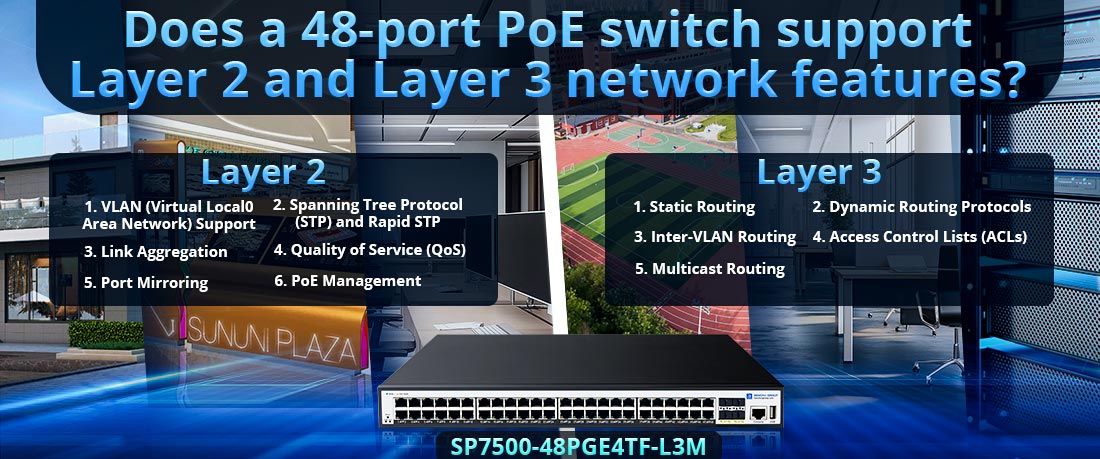
Oui, un commutateur PoE à 48 ports peut prendre en charge les fonctionnalités réseau de couche 2 et de couche 3, selon le modèle et ses spécifications. Voici une explication détaillée de ce que cela implique et de la manière dont ces fonctionnalités profitent à votre réseau :
Fonctionnalités de couche 2 dans un commutateur PoE à 48 ports
Les fonctionnalités de couche 2 sont fondamentales pour un transfert de données efficace au sein du même réseau local (LAN). Un 48 ports Commutateur PoE inclut généralement les fonctionnalités de couche 2 suivantes :
1. Prise en charge VLAN (réseau local virtuel) :
--- Permet la segmentation du réseau en groupes isolés pour une meilleure gestion du trafic, une sécurité et une réduction de la congestion.
2. Protocole Spanning Tree (STP) et STP rapide :
--- Empêche les boucles de réseau et assure la redondance, améliorant ainsi la fiabilité.
3. Agrégation de liens :
--- Combine plusieurs liaisons Ethernet pour une bande passante accrue et une prise en charge du basculement.
4. Qualité de service (QoS) :
--- Donne la priorité à des types de trafic spécifiques, tels que la VoIP ou la vidéoconférence, pour maintenir les performances.
5. Mise en miroir des ports :
--- Copie les paquets de données d'un port à un autre à des fins de surveillance ou de dépannage.
6. Gestion PoE :
--- Surveille et alloue l'alimentation aux appareils connectés, garantissant une utilisation efficace du budget d'alimentation du commutateur.
Fonctionnalités de couche 3 dans un commutateur PoE à 48 ports
La fonctionnalité de couche 3 offre des capacités de routage avancées, permettant aux données d'être dirigées entre différents réseaux (par exemple, LAN, VLAN). Certains 48 ports Commutateurs PoE sont livrés avec des fonctionnalités de couche 3 telles que :
1. Routage statique :
--- Dirige le trafic entre différents VLAN sans nécessiter de routeur externe.
2. Protocoles de routage dynamique :
--- Des protocoles tels que OSPF (Open Shortest Path First) ou RIP (Routing Information Protocol) permettent des mises à jour dynamiques et automatiques des itinéraires, ce qui est idéal pour les réseaux complexes.
3. Routage inter-VLAN :
--- Facilite la communication entre les VLAN sur le même commutateur, éliminant ainsi le besoin d'un routeur séparé.
4. Listes de contrôle d'accès (ACL) :
--- Ajoute la sécurité en contrôlant quels appareils ou adresses IP peuvent accéder au réseau.
5. Routage multidiffusion :
--- Optimise la livraison de données à plusieurs destinataires simultanément, couramment utilisé dans les applications de streaming vidéo ou IPTV.
Détermination de la couche 2 par rapport à la couche 3 dans un commutateur PoE à 48 ports
Commutateurs de couche 2 :
--- Axé sur la commutation au sein du LAN, en gérant le trafic avec les adresses MAC.
--- Généralement plus abordable et suffisant pour les petites et moyennes entreprises ayant des exigences réseau moins complexes.
Commutateurs de couche 3 :
--- Inclut des fonctionnalités de routage et conviennent aux entreprises qui doivent connecter plusieurs réseaux locaux, prendre en charge le routage dynamique ou gérer des modèles de trafic complexes.
Exemples de commutateurs PoE à 48 ports avec fonctionnalités de couche 2 et de couche 3
1. Gamme Cisco Catalyst 9200 :
--- Offre des fonctionnalités de couche 2 et 3 avec un routage avancé, une prise en charge VLAN et une gestion PoE robuste.
2. Ubiquiti UniFi Pro 48 PoE :
--- Principalement couche 2 avec quelques capacités de couche 3, idéales pour les réseaux d'entreprise évolutifs.
3. Netgear GS752TPP :
--- Un commutateur de couche 2+ avec des fonctionnalités limitées de couche 3 comme le routage statique, adapté aux petites et moyennes entreprises.
4. Série Aruba CX 6100 :
--- Couche 2 axée sur la prise en charge des VLAN, de la QoS et du STP, ainsi que du routage statique de base de la couche 3.
Considérations lors du choix de la couche 2 par rapport à la couche 3
Complexité du réseau : Choisissez des commutateurs de couche 3 pour les environnements multi-réseaux ou la communication inter-VLAN.
Évolutivité : Si vous prévoyez une croissance, les commutateurs de couche 3 offrent plus de flexibilité pour les extensions futures.
Budget: Les commutateurs de couche 2 sont économiques mais peuvent nécessiter des routeurs externes pour les configurations complexes.
Conclusion
A Commutateur PoE 48 ports peut prendre en charge les fonctionnalités de couche 2 et de couche 3, mais l'étendue de sa fonctionnalité de couche 3 varie selon le modèle. Pour les petites et moyennes entreprises, les fonctionnalités de couche 2 peuvent suffire, tandis que les commutateurs de couche 3 sont mieux adaptés aux entreprises disposant d'environnements multi-réseaux complexes. Évaluez toujours la taille de votre réseau, son potentiel de croissance et ses besoins spécifiques avant de prendre une décision.